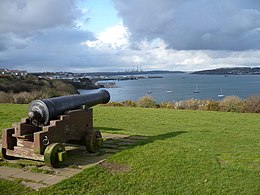Pembroke Dock
Pembroke Dock
|
|
|---|---|
 |
|
| Pembroke Dock shown within Pembrokeshire | |
| Population | 9,753 (2011) |
| OS grid reference | SM965035 |
| Principal area | |
| Ceremonial county | |
| Country | Wales |
| Sovereign state | United Kingdom |
| Post town | PEMBROKE DOCK |
| Postcode district | SA72 |
| Dialling code | 01646 |
| Police | Dyfed-Powys |
| Fire | Mid and West Wales |
| Ambulance | Welsh |
| EU Parliament | Wales |
| UK Parliament | |
Pembroke Dock (Welsh: Doc Penfro) is a community and a town in Pembrokeshire, South West Wales, lying north of Pembroke on the River Cleddau. Originally a small fishing village known as Paterchurch, the town was greatly expanded from 1814 onwards following the construction of a Royal Naval Dockyard. It is the third largest town in Pembrokeshire after Haverfordwest and Milford Haven.
The natural harbour offering shelter from the prevailing south westerly winds has probably been used for many thousands of years, but the first evidence of settlement from maps is the name of the Carr Rocks at the entrance, derived from the Norse-language Skare for rock.
From the 790s until the Norman Invasion in 1066, the Milford Haven estuary was used occasionally by Vikings looking for shelter. During one visit (possibly in 854, but more likely to be in 878 on his way to the Battle of Cynuit), the Viking chieftain Hubba wintered in the haven with 23 ships.
In 1172, three years after the Norman Invasion of Ireland, having prepared his fleet and army in the mouth of the Pembroke River, Henry II of England sailed there from the haven.
Prior to 1814, the site of modern Pembroke Dock and its nearby settlements were mostly farmland and the area was referred to as Paterchurch. The first recorded mention of Paterchurch was in 1289. In the area a medieval tower was built and, like nearby 18th century and 19th century fortifications, it may have served as a lookout post. By the 17th century, additional domestic and farm buildings stood close to the tower and the isolated settlement had its own cemetery, whose last recorded burial is that of a Roger Adams, in 1731. The ruin of the tower now lies within the walls of the dockyard.
...
Wikipedia

